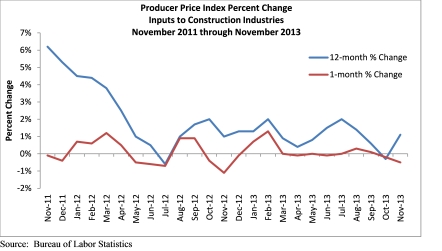Overall, construction materials prices fell 0.5 percent in November and are up only 1.1 percent year over year, according to the Department of Labor’s Dec. 13 Producer Price Index. Nonresidential construction materials are down 0.6 percent for the month and are 0.7 percent lower than the same time last year.
“November represented another month of remarkable stability for construction input prices,” said Associated Builders and Contractors (ABC) Chief Economist Anirban Basu. “Although many investors predicted significant inflation this year due to expansionary monetary policies in much of the developed world, there continues to be a lack of significant inflationary pressures both globally and nationally.”
Overall, the nation’s wholesale goods prices expanded 0.2 percent in November, but are down 0.9 percent year over year.
“Next year is unlikely to offer as much stability as 2013,” Basu said. “Global economic growth is set to accelerate and the apparent budget deal in Congress should produce greater certainty among businesses, helping improve an already benign national economic forecast. Tension in the Middle East also continues to be a consideration. Together, these factors suggest materials price increases may be at least slightly more rapid in 2014.”
THE FOLLOWING MATERIALS PRICES INCREASED IN NOVEMBER:
- Fabricated structural metal products were up 0.1 percent for the month and 0.3 percent year over year.
- Softwood lumber prices increased 2.6 percent on a monthly basis and are up 12.8 percent year over year.
- Natural gas prices were up 1.9 percent for the month and 3.3 percent on an annual basis.
- Nonferrous wire and cable prices rose 0.2 percent on a monthly basis and are down 3 percent year over year.
- Iron and steel prices were up 1.8 percent for the month and are down 0.1 percent compared to the same time last year.
- Prices for plumbing fixtures and fittings inched up 0.1 percent in November and are up 1.6 percent year over year.
- Steel mill products prices increased 0.8 percent in November but are down 0.6 percent compared to the same time last year.
THE FOLLOWING CONSTRUCTION INPUTS EXPERIENCED PRICE DECREASES IN NOVEMBER:
- Prepared asphalt, tar roofing and siding prices were down 3.8 percent for the month and 0.3 percent year over year.
- Crude petroleum prices fell 10.3 percent on a monthly basis but are up 0.9 percent year over year.
- Crude energy prices decreased 5.7 percent in November but are up 0.6 percent compared to the same time last year.
- Concrete products prices were flat in November and are up 2.8 percent year over year.
Related Stories
| Aug 11, 2010
PCA partners with MIT on concrete research center
MIT today announced the creation of the Concrete Sustainability Hub, a research center established at MIT in collaboration with the Portland Cement Association (PCA) and Ready Mixed Concrete (RMC) Research & Education Foundation.
| Aug 11, 2010
Study explains the financial value of green commercial buildings
Green building may be booming, especially in the Northwest, but the claims made for high-performance buildings have been slow to gain traction in the financial community. Appraisers, lenders, investors and brokers have found it difficult to confirm the value of high-performance green features and related savings. A new study of office buildings identifies how high-performance green features and systems can increase the value of commercial buildings.
| Aug 11, 2010
Architecture Billings Index flat in May, according to AIA
After a slight decline in April, the Architecture Billings Index was up a tenth of a point to 42.9 in May. As a leading economic indicator of construction activity, the ABI reflects the approximate nine to twelve month lag time between architecture billings and construction spending. Any score above 50 indicates an increase in billings.
| Aug 11, 2010
Architecture Billings Index drops to lowest level since June
Another stall in the recovery for the construction industry as the Architecture Billings Index (ABI) dropped to its lowest level since June. The American Institute of Architects (AIA) reported the August ABI rating was 41.7, down slightly from 43.1 in July. This score indicates a decline in demand for design services (any score above 50 indicates an increase in billings).
| Aug 11, 2010
RTKL names Lance Josal president and CEO
Lance K. Josal FAIA has been named President and CEO of RTKL Associates Inc., the international planning, design and engineering firm. Josal succeeds RTKL’s current President and CEO, David C. Hudson AIA, who is retiring from the firm. The changes will take effect on 1 September 2009.
| Aug 11, 2010
Balfour Beatty agrees to acquire Parsons Brinckerhoff for $626 million
Balfour Beatty, the international engineering, construction, investment and services group, has agreed to acquire Parsons Brinckerhoff for $626 million. Balfour Beatty executives believe the merger will be a major step forward in accomplishing a number of Balfour Beatty’s objectives, including establishing a global professional services business of scale, creating a leading position in U.S. civil infrastructure, particularly in the transportation sector, and enhancing its global reach.
| Aug 11, 2010
Construction unemployment rises to 17.1% as another 64,000 construction workers are laid off in September
The national unemployment rate for the construction industry rose to 17.1 percent as another 64,000 construction workers lost their jobs in September, according to an analysis of new employment data released today. With 80 percent of layoffs occurring in nonresidential construction, Ken Simonson, chief economist for the Associated General Contractors of America, said the decline in nonresidential construction has eclipsed housing’s problems.
| Aug 11, 2010
Billings at U.S. architecture firms exceeds $40 billion annually
In the three-year period leading up to the current recession, gross billings at U.S. architecture firms increased nearly $16 billion from 2005 and totaled $44.3 billion in 2008. This equates to 54 percent growth over the three-year period with annual growth of about 16 percent. These findings are from the American Institute of Architects (AIA) Business of Architecture: AIA Survey Report on Firm Characteristics.








